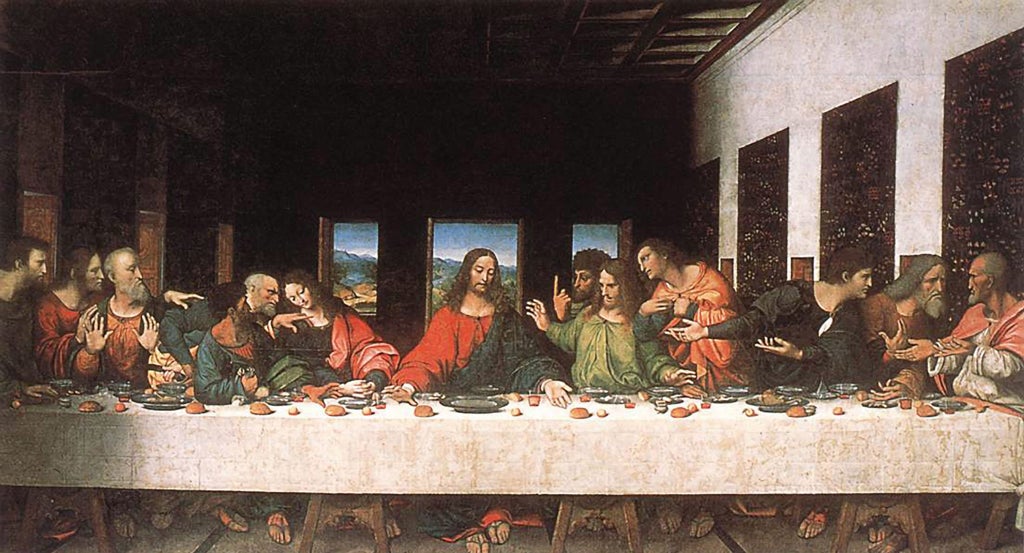The other Da Vinci code: did Leonardo paint himself into The Last Supper?
For years scholars have wondered what he looked like. But was the answer staring them in the face all along?

It is a question that has fascinated art historians: what did Leonardo da Vinci look like?
The Renaissance genius left no youthful self-portraits, although academics have long suspected that he may have inserted his likeness into one of his own masterpieces.
But now one art expert has proposed a tantalising new theory – that Leonardo actually depicted himself, twice, in The Last Supper, one of art's most famous paintings.
Ross King, the author of the international bestseller Brunelleschi's Dome, believes Leonardo used his own face for the apostles Thomas and James the Lesser in the 500-year-old mural in Milan.
His evidence lies partly in a little-known poem written in the 1490s – when Leonardo was painting The Last Supper. Its author, Gasparo Visconti, was a friend of the artist and, like him, a Sforza court employee.
In humorous verse, Visconti mocks an unnamed artist for putting his self-portrait into his paintings – "however handsome it may be" – and with his own "actions and ways", namely gestures and expressions.
Leonardo's own good looks were legendary, recorded by his 16th century biographer, Giorgio Vasari, as "endowed by heaven with beauty, grace and talent". And Thomas's upraised finger gesture in the painting was viewed by contemporaries as a Leonardo trademark.
Dr King also points to a red chalk drawing, believed to depict Leonardo around 1515, sketched by one of his assistants. It shows a classically handsome man with a Greek nose, flowing hair and a long beard – "a rare sight on the chins of 15th century Italians", he notes. In The Last Supper, Thomas – to the right of Christ – and James the Lesser – second from left – are reminiscent of that image – both with a Greek nose, flowing hair and a beard.
Dr King told The Independent: "The Last Supper is the only work that no one – either crackpot or academic – has tried to identify as a Leonardo portrait."
Bloomsbury Publishing will publish his latest research in Leonardo and The Last Supper on 30 August, coinciding with its choice as BBC Radio 4's Book of the Week.
Little of Leonardo's original mural, painted for the refectory of the Santa Maria delle Grazie monastery, survives today. Besides deteri oration, Allied bombing exposed it to the elements and its subsequent restoration left critics divided.
In his book, Dr King writes that "Leonardo-spotting has become a popular pastime" with numerous supposed identifications. He adds that the most famous is the supposed self-portrait of an old man in red chalk. However, as it is now believed to date from the 1490s – contemporary with The Last Supper – it cannot be a self-portrait.
Charles Nicholl, the noted Leonardo scholar, said: "Of all the apostles that [Leonardo] would wish to be identified with, I think Doubting Thomas would be top of his list because Leonardo was a great believer in asking questions rather than accepting what people tell you."
In the picture: Artists in their own works
Michelangelo Thought to have depicted himself as a flayed figure in The Last Judgment, 1533-41, in the Sistine Chapel. Far from a conceited gesture, he showed himself as one of the damned.
Velázquez In Las Meninas, his 1656 portrait of the Spanish royal family that plays with illusion and reality, he portrayed himself painting the painting.
Mantegna In Presentation at the Temple, c 1460, he is thought to be emerging from the darkness at the right of the composition.
Benozzo Gozzoli Put his self-portrait in the Procession of the Magi fresco, 1459-60. He places himself in the regal entourage, looking out at the viewer and wearing a red hat marked "Opus Benotii".
Join our commenting forum
Join thought-provoking conversations, follow other Independent readers and see their replies
Comments
Bookmark popover
Removed from bookmarks